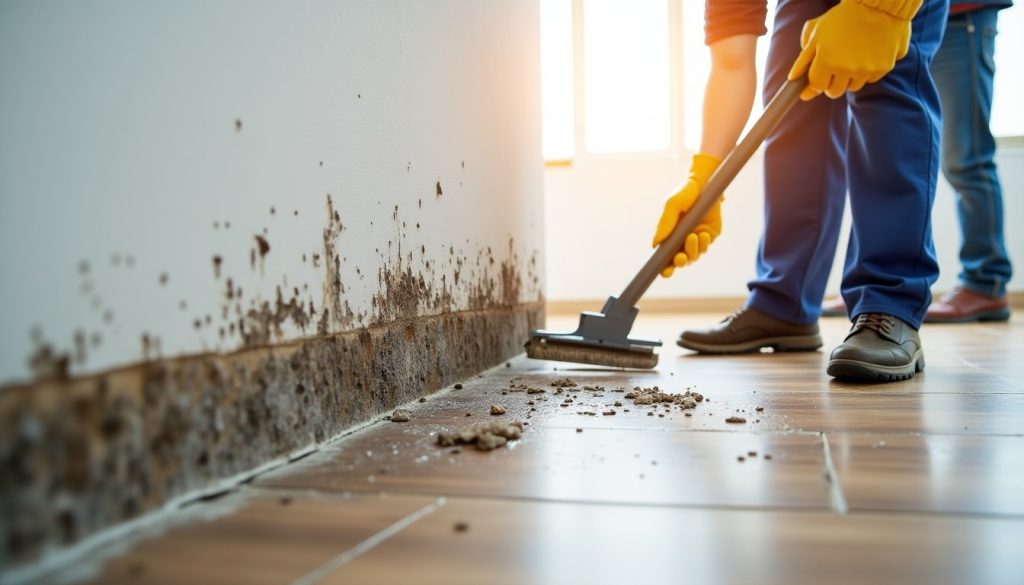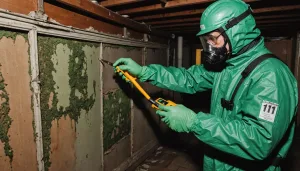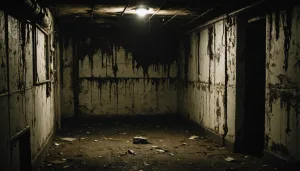Water damage is an insidious problem that can quickly lead to the need for water damage restoration and, if left unchecked, create an environment ripe for mold growth. Understanding and identifying the common sources of water damage in your home is critical to effective mold prevention and maintaining home health. By being proactive, homeowners can mitigate potential problems before they escalate into more significant issues.
One of the most frequent sources of water damage is weather-related incidents. Heavy rainstorms, thunderstorms, and hurricanes can all result in flooding, which directly impacts the integrity of your home. It’s essential to regularly check your roof for missing shingles or damage and ensure gutters and downspouts are clear of debris, to direct rainwater away from the foundation.
Plumbing issues are another common culprit when it comes to water damage. Burst or leaky pipes can result from old, corroded plumbing, poor installation, or even extreme temperature changes. Regular inspection by a licensed plumber can preemptively catch small leaks or weaknesses in your plumbing system, preventing the escalation of minor drips into major water damage disasters.
- Inspect and repair roof damage promptly to prevent leaks.
- Clear and maintain gutters to ensure proper water drainage.
- Schedule regular plumbing checks to catch leaks early.
Appliance failures also contribute significantly to water-related issues in homes. Washing machines, dishwashers, water heaters, and refrigerators with ice makers have water lines that can accidentally become disconnected or develop leaks. Regular inspection of these water connections and replacing old or deteriorating hoses can help avert potential water damage.
In addition to the aforementioned sources, poor ventilation, particularly in high-moisture areas like bathrooms and kitchens, can lead to condensation buildup, resulting in water damage. Ensure that these spaces have adequate ventilation systems and keep an eye out for signs of moisture collection on walls or ceilings.
- Routinely check appliance water connections and hoses for wear and tear.
- Install proper ventilation in bathrooms and kitchens to minimize moisture buildup.
Furthermore, it’s important to be cautious of water seepage in basements. Cracks in the foundation or walls can allow water to invade these lower parts of the home, which often go unnoticed until significant damage occurs. Applying water sealant to walls and floors and ensuring proper drainage around the home can mitigate this risk.
| Source | Potential Impact | Prevention Strategy |
| Weather-related flooding | Compromised home structure | Roof and gutter maintenance |
| Plumbing leaks | Water damage to walls and floors | Regular plumbing inspections |
| Appliance failures | Water damage in kitchen/laundry | Monitor and replace old hoses |
| Poor ventilation | Moisture buildup and mold risk | Install robust ventilation systems |
| Basement seepage | Foundational water damage | Use sealants and drainage systems |
Recognizing these common sources of water damage is not only essential for preventing immediate issues but also for long-term mold prevention and safeguarding the overall health of your home. By maintaining vigilance and implementing these preventative measures, homeowners can effectively protect their investment and ensure the safety of their living environment.
Essential steps for immediate water removal
When facing water damage, taking immediate action is vital to prevent further problems, including mold growth, which can compromise home health. Whether the issue is due to a flooding incident, a burst pipe, or an overflowing appliance, managing the situation promptly can save you from costly water damage restoration later. Follow these essential steps for immediate water removal to protect your home and its inhabitants.
- Ensure Safety First
- Before any attempt to remove water, ensure the safety of everyone in the home. If there is a significant amount of water, turn off the electricity to prevent the risk of electrocution.
- Assess the situation quickly to determine if professional help is required, especially in cases where contaminated water is involved.
- Stop the Water Source
- Identify and stop the source of the water. If a pipe has burst, turn off the main water supply immediately.
- Seal any visible breaches temporarily, or consult with a professional for a more secure repair if necessary.
- Remove Standing Water
- Use a wet-dry vacuum cleaner if available, which is specifically designed to handle water intrusions.
- If the amount of water is minimal, towels and mops should suffice. For severe flooding, rely on professional water extraction services.
- Move Furniture and Belongings
- Quickly relocate furniture, carpets, and other items away from wet areas. This not only prevents further damage but also allows more efficient water removal and drying.
- Take care with your electronics and remove them from waterlogged areas to prevent any further damage or potential hazards.
- Facilitate Airflow
- Open windows and doors to promote ventilation. Using fans and dehumidifiers will help speed up the drying process, reducing the chance for mold to develop.
- Ensure that affected areas such as carpets, walls, and floors receive adequate airflow to minimize moisture retention.
- Inspect and Clean
- Once most of the water has been removed, inspect the affected areas for any remaining moisture. Pay special attention to spaces like behind baseboards or inside cabinets where water can hide.
- Clean these areas thoroughly with a disinfectant to mitigate any health risks from potential contaminants in the water.
- Document the Damage
- Take photographs and note the extent of the damage. Documentation will be essential for insurance claims and in assessing the need for professional water damage restoration services.
- Keep a detailed record of any items that were damaged or required removal during the process.
Reacting swiftly by following these steps not only aids in mold prevention but also contributes significantly to maintaining the overall health of your home. Addressing water damage efficiently can alleviate long-term problems and ensure a safe and habitable environment.
Effective drying techniques for your home
Water is often a homeowner’s biggest challenge when it comes to maintaining a dry and safe home, as it can stealthily seep into various parts of the building and create a breeding ground for mold. After removing standing water, the next crucial task is to ensure all affected areas are thoroughly dried. This step is vital not only for mold prevention but also for maintaining home health and minimizing the need for extensive water damage restoration.
To begin, maximize natural ventilation. Opening windows and doors allows fresh air to enter your home and circulate effectively, which aids in the drying process. If the weather is particularly humid or if outdoor temperatures are extreme, complementing natural airflow with mechanical assistance is often necessary. Strategically placing fans throughout the affected areas can speed up the evaporation process and reduce the risk of moisture retention in walls, floors, and furniture. Consider using high-powered fans like industrial floor fans or air movers as they are designed to handle significant moisture issues more efficiently than regular household fans.
Dehumidifiers play a crucial role in reducing humidity levels in the air. These machines extract moisture from the environment, which is especially beneficial in enclosed spaces like basements or interior rooms without windows. By removing excess moisture from the air, dehumidifiers prevent mold growth, a common issue following water damage. Make sure to regularly check and empty the water tank of the dehumidifier to ensure it operates effectively over time.
Focus on hidden and porous materials, as these are often neglected and can harbor moisture undetected. Carpeting, upholstery, and insulation are some of the biggest culprits. For instance, even if you’ve removed surface water from a carpet, moisture can still be trapped underneath. Pull back the carpet and padding to verify they are dry before repositioning them. In severe cases, replacement may be the only option. Upholstered furniture should be placed in direct airflow to enhance drying, and for small items, direct sunlight can be an excellent natural drying agent.
Walls and floors require special attention to ensure there is no trapped moisture that could lead to long-term damage. For walls, consider removing baseboards and drilling small holes near the floor to allow trapped water to escape and to promote airflow behind walls. If drywall becomes saturated, it might need to be replaced entirely to avoid hidden mold growth. Floors, especially wood and laminate, may appear dry but can conceal moisture below the surface. Use moisture meters to assess these areas and determine if additional drying measures are required.
Lastly, the use of specialized drying equipment like desiccant dehumidifiers or infrared lamps can enhance the drying process, particularly in challenging conditions or when traditional methods prove inadequate. These advanced tools are often available for rent at hardware stores or through professional services, making them accessible for focused drying projects.
By implementing these effective drying techniques, homeowners can protect their investment and ensure a dry, safe, and healthy living environment. It significantly reduces the risk of mold and other moisture-related damages, thus preserving the structural integrity and overall health of the home.
Using mold-resistant materials and products
When it comes to creating a barrier against mold and enhancing the long-term durability of your home, the selection of materials plays a pivotal role. One of the most effective strategies for mold prevention after water damage is to use mold-resistant materials and products that not only combat moisture but also inhibit mold growth from the outset.
Start by considering the type of paint used on walls and ceilings in high-moisture areas like bathrooms, kitchens, and basements. Mold-resistant paints contain antimicrobial agents that prevent mold and mildew from forming on the painted surfaces. This simple switch in your home improvement plan can contribute significantly to maintaining home health by providing ongoing mold protection.
Flooring options are another critical area where mold-resistant materials can be advantageous. Traditional carpet can trap moisture and provide a perfect breeding ground for mold spores. Alternatively, opt for flooring materials such as ceramic or porcelain tiles, which are impervious to water and easy to clean. For areas where you still prefer the warmth of carpet, consider mold-resistant carpet pads that are specifically designed to mitigate water damage and mold risks.
In addition, use mold-resistant drywall, often referred to as green board, especially in rooms prone to moisture exposure. While traditional drywall can absorb moisture and subsequently foster mold growth, mold-resistant drywall incorporates fiberglass facing, which reduces water absorption and resists mold formation. This is a beneficial upgrade during renovations or when addressing water damage restoration projects.
For areas requiring insulation, select mold-inhibiting products such as closed-cell spray foam or mold-resistant fiberglass that resist moisture intrusion. Unlike traditional insulation, these materials do not support mold growth, thereby ensuring the structural integrity of your home and contributing positively to the overall home health.
In aspects like cabinetry or woodwork where water resistance is crucial, consider using materials like stainless steel or marine-grade plywood which offer enhanced durability and are inherently resistant to moisture. These materials not only resist mold but also ensure longevity in challenging environments such as kitchens and bathrooms.
Finally, incorporating mold inhibitors into cleaning routines can also offer added protection. Products that contain mold-resisting chemicals can be applied to surfaces like tile grout, shower curtains, and even outdoor decks, providing an extra layer of defense against mold infiltration.
By strategically selecting and using mold-resistant materials and products, you not only engage in proactive mold prevention but also enhance your home’s resilience against future water damage. Such investments are crucial in safeguarding home health, ensuring that your living environment remains safe and structurally sound for years to come.
Regular maintenance and inspection tips
In order to ensure effective mold prevention and maintain optimal home health, regular maintenance and inspections are crucial. By adhering to a consistent schedule of examinations and addressing potential issues before they escalate, homeowners can significantly reduce their risk of water damage restoration needs and foster a safer living environment.
Begin by checking the home’s exterior, particularly focusing on the roof and walls for signs of wear or damage. Missing or curled shingles can allow water intrusion, while cracks in the siding or foundation may lead to basement seepage. Repair these promptly to avoid further complications. Pay special attention to gutter and downspout systems; they should be free from debris and securely attached to facilitate proper water flow away from the home.
Internally, routine plumbing inspections are essential. Examine pipes under sinks, behind washing machines, and near appliances for any signs of corrosion, leaks, or condensation. Even the smallest of leaks can develop into significant problems if disregarded. Appliances that use water, like dishwashers, water heaters, and refrigerators, should be regularly inspected and maintained according to manufacturer guidelines to ensure they are functioning correctly. Additionally, ensure that seals around doors and windows remain intact, as poor seals can contribute to moisture ingress.
The installation and regular servicing of ventilation systems, specifically in high-moisture areas like bathrooms and kitchens, are critical. Proper ventilation discourages moisture accumulation, thus reducing the potential for mold growth and maintaining a more comfortable home environment. Schedule regular cleanings of exhaust fans and air ducts to ensure efficient operation.
Checking humidity levels is another important task in the pursuit of mold prevention and optimal home health. Utilize a hygrometer to monitor indoor humidity, keeping it below 60%. If necessary, use dehumidifiers in damp areas such as basements or laundry rooms. Ensuring controlled humidity levels can help to prevent both mold and moisture damage.
Finally, schedule periodic professional inspections to assess the home’s current condition. An expert can identify potential problem areas and recommend corrective actions to bolster the home’s resistance to water damage and mold.
Consistent and thorough inspections and maintenance efforts are indispensable in protecting your home from water damage and ensuring long-term health and safety. By taking proactive steps to routinely assess and address potential vulnerabilities, homeowners can efficiently prevent mold growth, safeguard their investment, and uphold a nurturing and secure living space.
In conclusion, managing water damage and preventing mold in your home requires a comprehensive approach that includes identifying potential water damage sources, immediate water removal, effective drying techniques, using mold-resistant materials, and regular inspections. By staying vigilant and proactive, homeowners can protect their properties, maintain home health, and create a safe, mold-free environment.





